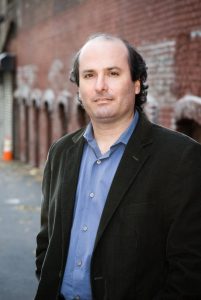Too often throughout history, the record and story of what’s told is governed by principles outside of fact and truth. In a growing age of technology and information, more stories are being uncovered and brought into the forefront.

David Grann has made a career of doing just that. Through his stories and work, he has helped shine a light on areas of history around the world that have, for too long, gone unnoticed or been forgotten by the general public.
Grann, best-selling author and award-winning staff writer for The New Yorker, will be speaking at 10:45 a.m. Tues., Aug. 14, in the Amphitheater.
Grann’s most recently published book, Killers of the Flower Moon: The Osage Murders and the Birth of the FBI, was a No. 1 New York Times best-seller and 2017 finalist for the National Book Award.
Killers of the Flower Moon looks into the string of murders of the wealthy Osage people in Oklahoma in the 1920s and the racism and conspiracy that surrounded these crimes. Forced into a rocky corner of Oklahoma, the tribe became one of the wealthiest groups in the country thanks to an abundance of oil beneath the land. Crime and corruption quickly followed.
Grann didn’t know of these tragedies that befell the Osage before visiting the Osage Nation Museum in 2012, but he took notice of a large panoramic photograph he saw there of both of early white settlers and the Osage people — with a panel cut out.
“The museum director pointed to the missing panel and said, ‘The devil was standing right there,’ ” Grann said. “She then brought up the missing panel, and it showed the killers of the Osage.”
The missing image — containing William H. Hale, the mastermind behind many of the Osage murders — was the origin point of his research in many ways, Grann said, and contained a symbolic message for what the overall story would end up being.
“The museum director, the Osage, had removed that photo because they were deeply aware of its history and it was so painful,” Grann said. “So many people didn’t know about this history, including me.”
Through five years of research, pulling records, speaking with victims’ families and documenting timelines, the story took shape. At first, Grann said he began to see the story as a traditional crime novel, with one person as the mastermind behind these crimes — the narrative the FBI and other officials had handed down for years.
Through time and research, Grann began to see this story wasn’t so accurate. Grann said he began to note that there were numerous mysterious deaths and murders that weren’t solved or tied up, and the story quickly became “who didn’t do it.”
“It was really about a culture of killing,” Grann said. “That’s really a more difficult truth to accept and reckon with. My perception and the way I told the story changed dramatically over time as I gathered more evidence.”
Putting more focus and interest on gathering photographs with this project than any other before, Grann said these images of victims and their families became the motivation and driving force for him behind telling this historical tale.
“Each project is different, and the sort of motivations around each project are different,” Grann said. “These photographs, they were reminders of what the project was about for me — remembering and trying to document what had happened to these people. Their lives are a part of our history that we, including myself, for too long excluded and kept out of our consciousness.”
Finding stories like this to tell with either his books or articles in The New Yorker, Grann said, is just a product of listening and talking to people.
“It’s extremely hard to find them,” Grann said. “That’s the biggest challenge. During almost every waking hour, you have one ear tilted thinking, ‘Oh, would that be a good story?’ ”
After finding and diving into a story, Grann said the deciding factor for whether a story becomes an article or a book depends on whether or not he’s willing to live with the subject matter for a few months, or years at a time.
“The methodology in some ways is similar,” Grann said. “You’re kind of following one clue to the next, going from one bit of information to the next bit of information. They both involve a great deal of research.”
Grann said he doesn’t think much about where he wants to go as a writer, and that living in the present keeps him from becoming complacent. Grann said he just feels blessed to be able to do what he does and hopes to continue finding stories that are worth being told.
“The thing that gets me excited is to realize and sink into a story and almost get lost in it, sometimes for too many years at at time,” Grann said.
Grann said he’s honored to be a part of this week’s theme, “The Forgotten: History and Memory of the 21st Century,” something he finds very important. Grann said he was glad to be able to share the tragic case of the Osage killings that for too long has been forgotten.
“I’m glad that places are putting the focus on these forgotten or overlooked parts of our history,” Grann said. “That wasn’t necessary for the Osage. They are very aware of this history. It was very necessary, unfortunately, for many others.”
Grann’s next work, The White Darkness, will be released this fall. Based off a story he published for The New Yorker, the story deals with Henry Worsley, who obsessively modeled his life after famed arctic explorer Ernest Shackleton, whom Grann called one of the greatest leaders of his era.




